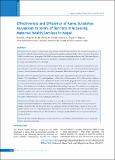Please use this identifier to cite or link to this item:
https://hdl.handle.net/20.500.14356/1991| Title: | Effectiveness and Eficiency of Aama Surakshya Karyakram in terms of Barriers in Accessing Maternal Health Services in Nepal |
| Authors: | Bhusal, C L Singh, S P BC, R K Dhimal, M Jha, B K Acharya, L Thapa, P Magar, A |
| Citation: | BhusalC. L., SinghS. P., BCR. K., DhimalM., JhaB. K., AcharyaL., ThapaP., & MagarA. (2011). Effectiveness and Eficiency of Aama Surakshya Karyakram in terms of Barriers in Accessing Maternal Health Services in Nepal. Journal of Nepal Health Research Council. https://doi.org/10.33314/jnhrc.v0i0.280 |
| Issue Date: | 2011 |
| Publisher: | Nepal Health Research Council |
| Article Type: | Original Article |
| Keywords: | Aama surakshya karyakram Barriers Effectiveness and efficiency maternal health services Nepal Safe delivery incentive programme |
| Series/Report no.: | October;280 |
| Abstract: | Abstract Background: The Family Health Division along with the MoHP developed a policy that recommended provision of incentives to all delivering mother by removing the parity condition and termed Safe Delivery Incentive Programme (SDIP) to make it more appropriate. The SDIP was branded as AamaSurakshyaKaryakram (ASK). The main objective of the study was to find out the effectiveness and efficiency of AamaSurakshyaKaryakram to address barrier in accessing maternal health services in Nepal. Methods: An exploratory and cross sectional descriptive study was conducted by quantitative and qualitative tools and techniques. To provide comprehensive coverage, five districts have been selected representing four development (eastern, central, western and far-western) and three (mountain, hill and flat) ecological region were selected. Results: Out of 47 exit client interviews conducted in this study, 51percent were done in Sunsari, followed by Sarlahi (17%), Dadeldhura (17%), and Arghakhanchi (15%). Most of these mothers (94%) delivered their children in the hospitals, and rest (6%) in PHCCs. Sixty percent mothers were in the age group of 20-25 years, while 45 percent were from Tarai/Madhesi group followed by Brahmins/Chhetries group (34%). Total 70% mothers were found to be literate. 55% mothers were found to be visiting health facilities during labour pain. 2% mothers were visiting heath facilities before labour pain started. Rest mothers were visiting health facilities after one or two days of labour pain. Total 70% mothers were able to reach the health facility within 60 minutes, while 13 percent mothers were able to reach the facility more than 3 hours, and 17% were in between. All mothers who visited PHCCs were able to reach the facility within 60 minutes while analyzing health facility-wise. Conclusions: Mothers delivered at home as they were not well prepared to go to health facility. Lack of transportation facility hindered for institutional delivery. None of them figured out that there was a provision of transport incentive; they only knew that there was a cash payment, but they didn’t know exactly for what specific purpose mothers were receiving such payments. Ask found to be effective and efficient in order to address barriers occurring inside the health facility and financial barrier except geo-graphical barrier in accessing maternal health services in Nepal. Keywords: aama surakshya karyakram, barriers, effectiveness and efficiency maternal health services, Nepal, safe delivery incentive programme. |
| Description: | Original Article |
| URI: | http://103.69.126.140:8080/handle/20.500.14356/1991 |
| ISSN: | Print ISSN: 1727-5482; Online ISSN: 1999-6217 |
| Appears in Collections: | Vol 9 No 2 Issue 19 October 2011 |
Files in This Item:
| File | Description | Size | Format | |
|---|---|---|---|---|
| 280-Article Text-278-1-10-20130822.pdf | Fulltext Download | 951.86 kB | Adobe PDF |  View/Open |
Items in DSpace are protected by copyright, with all rights reserved, unless otherwise indicated.
